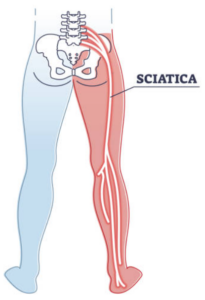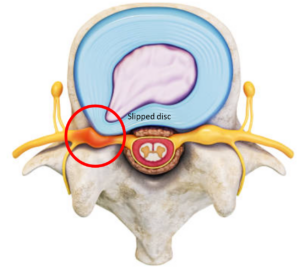What is Sciatica?
Sciatica is a painful condition of the lower back/leg. Sciatica is associated with injury, inflammation, pressure, damage, or irritation of the sciatic nerve, which originates in the hip area and runs down the legs.(1) Sciatica normally affects only one leg at a time. However, sciatica can affect both legs.(2) Sciatica affects about 40% of Americans, and the percentage is higher in the older population.(3) Furthermore, men are up to three times as likely as women to suffer from sciatica-induced pain.(4)

Patient Experience of Sciatica
Depending on the cause, people have described sciatica pain as a “feeling of stabbing,” “burning like pain,” or “the pain of an electric shock.”(5) Sciatica could be a long-term or occasional episode, depending on the patient. Sciatica could result in muscle weakness in the affected leg, numbness, unpleasant tingling, and a needle-like sensation in the foot and toes.
What Causes Sciatica?
Sciatica may occur when there is any kind of damage to the sciatic nerve. Multiple factors may contribute to sciatica, including the following:
- Slipped disc

A slipped disc is the primary cause of sciatica. A slipped disc affects 1 – 5% of Americans at some time in their lives. As shown in the picture, the disc in the backbone compresses the sciatic nerve, triggering sciatica.
- Osteoarthritis
- Spinal stenosis
- Injury to the sciatic nerve
The Sciatic Nerve is Not the Only Source of Sciatica
Sometimes the source of the pain could be higher than the sciatic nerve and may cause discomfort in front of the thigh or hip area. This pain is still called sciatica.(6)
Conditions that Can Increase the Chances of Developing Sciatica(7)
- Previous injury
- Being overweight
- Not so active lifestyle
- Wrong posture while sitting for long hours
- Osteoarthritis
- Smoking
- Elderly age
- Arthritis
- Diabetes
Diagnosis of Sciatica
A healthcare provider diagnoses sciatica after a physical examination of the patient. Depending on the results of the physical examination, further tests might be done, including the following:
- Back X-rays to see if there is a presence of any spinal fractures and bone protrusions (bone spurs)
- Magnetic resonance imaging (MRI) or computed tomography (CT) scans to see detailed images of bones (vertebrae) and soft tissue. MRI can detect the bone protrusion pressing the nerve(8)
Treatment of Sciatica
Reducing sciatica-related pain and restoring the patient’s ability to move freely are the primary goals of therapy. Often, the pain begins and fades on its own within a few hours or days. However, the pain may last for several weeks or even months. The good news is that several treatment options exist to relieve pain and improve spinal health.
- Self-care treatments include:
- Application of cold or hot packs: Applying a cold pack (ice pack) for 20 minutes at a time several times a day may help. If the pain still persists, one may switch to hot packs (heating pads) after several days of ice pack treatment. Heating pads can be used for 20 minutes at a time.
- Doing simple stretches and exercises: Learning and performing simple stretching exercises may improve flexibility and mobility. Strengthening the core muscles by exercising can help.
- Reducing sitting in one position for an extended period: Going for short walks after each hour of sitting in one position may help to relieve pain.
- Adjusting the seating position to be more ergonomic (comfortable for the body): Making adjustments to the chair and desk will make sitting more comfortable.
- Body weight management: Increased body weight is one of the important factors contributing to sciatica. Controlling body weight may help relieve the pain.
- Other habitual factors: Besides exercising and maintaining proper body posture, people should stop smoking and start an active lifestyle.
- Treatment with over-the-counter medicines: Medications can be taken to relieve the pain, inflammation, or swelling. Medicines include aspirin, ibuprofen (Advil), or acetaminophen (Tylenol). Discuss the possible side effects with a pharmacist before taking any medicines.
- Alternative health care services
- Massage: Getting a back massage for sciatica may help patients. Massage for sciatica is different from a usual spa massage as it involves putting pressure on the inflamed part of the back. Besides massage, yoga and acupressure treatment may help relieve the pain in patients.
- Physical therapy: Healthcare providers can refer patients to physical therapy. The goal of physical therapy is to improve body movement and increase blood flow to the spine, which takes away toxins from the pain site.
- Spinal injections: An injection of corticosteroids (an anti-inflammatory drug) in the spine can be helpful to reduce the inflammation, swelling, and pain associated with it. This treatment can provide temporary relief (up to three months following the injection). Spinal injections are given under local anesthetic.
- Chiropractic treatment: During a visit to a chiropractor, the spinal column can be realigned, giving relief from sciatica.
When One Needs to See a Doctor for Sciatica
Sometimes, sciatica can be a serious problem, particularly when a patient experiences the following symptoms:
- Sudden numbness
- Unbearable leg pain that lasts for a few hours
- Loss of bladder or bowel control
- Failure to move legs
- Presence of extreme pain that cannot be stopped by medications
The Surgical Option for Sciatica
If all other treatment options fail, spinal surgery can be considered by healthcare providers. However, given the risks associated with the surgery, including bleeding, infections, nerve damage, and loss of bladder or bowel control.
A final word about sciatica: Many people experience sciatica in the United States as well as all over the world. Most of these cases do not require surgery to relieve the pain. Sciatica may resolve on its own with time. In cases where the pain lasts for a longer duration, a healthcare provider should be contacted. Embracing an active and healthy lifestyle is the best way to prevent sciatica (in non-accidental cases). In accidental cases, proper stretching and exercising with help from alternative therapies including yoga, massage, chiropractic adjustments, acupressure, and acupuncture may improve flexibility and movement in patients.
